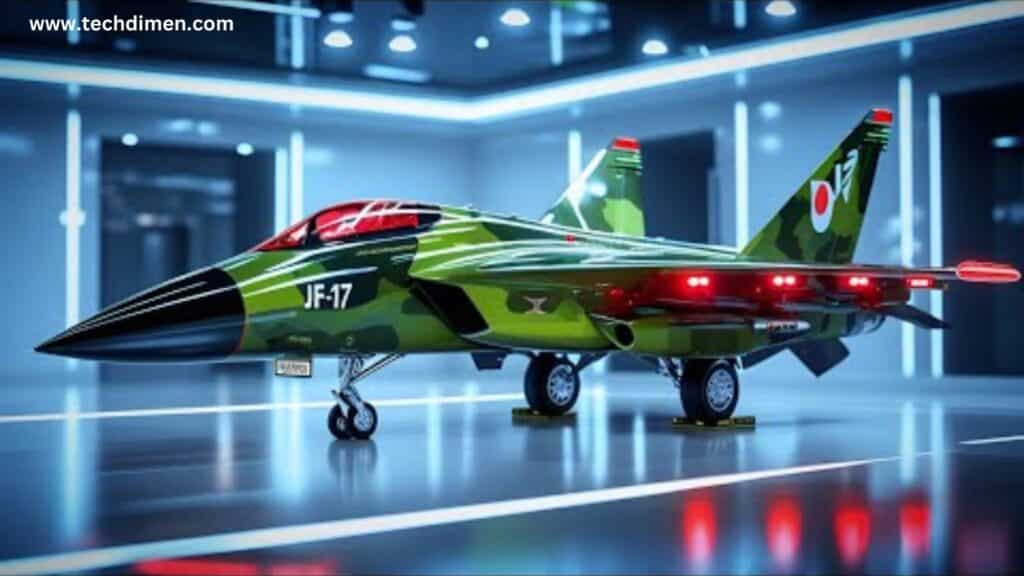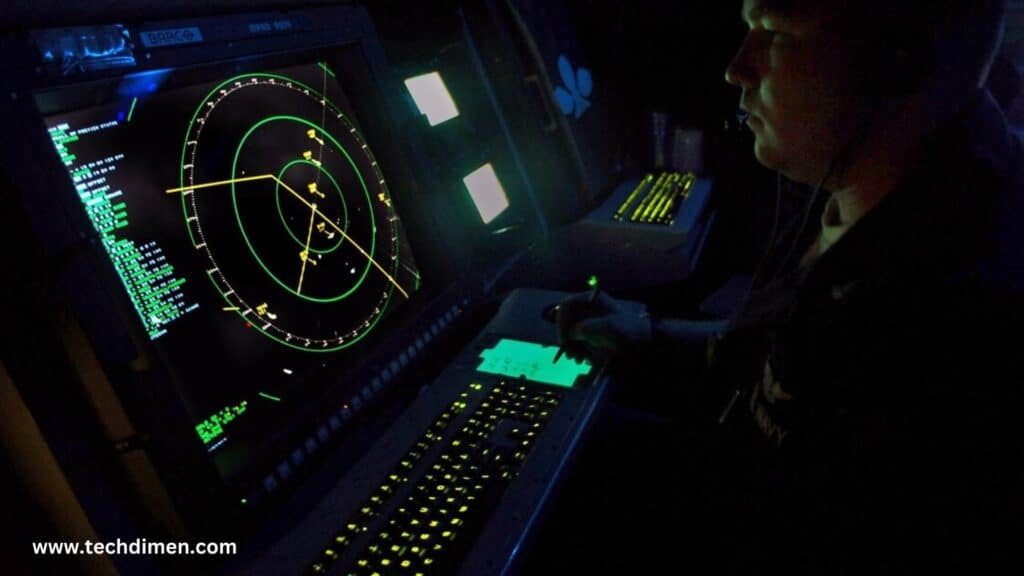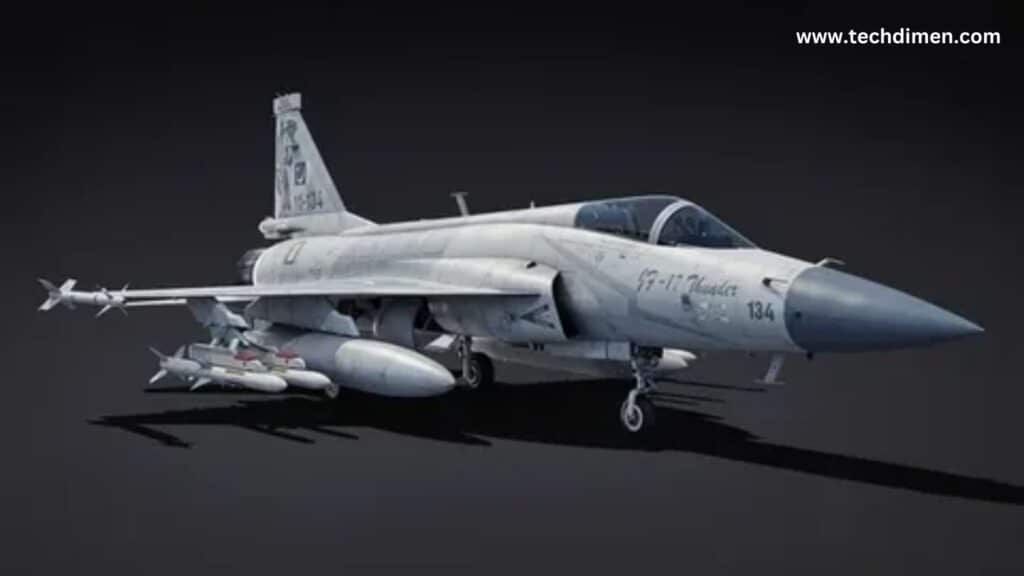The JF‑17 Thunder Jet Technology, or Chengdu FC-1 Xiaolong, has emerged as one of the most strategically significant developments in 21st-century aerial warfare. Born from a collaboration between the Pakistan Aeronautical Complex (PAC) and Chengdu Aircraft Corporation (CAC) in China, it symbolizes a shift towards indigenous innovation and affordability in fighter jet technology. Designed for versatility, agility, and precision, the JF-17 blends advanced avionics, multi-role combat capabilities, and streamlined maintenance into a sleek, fourth-generation platform. Its emergence marks a shift in global airpower dynamics, offering high tech performance at a fraction of traditional fighter jet costs.
Origins of the JF‑17 Thunder Jet Technology Program

Why theJF‑17 Thunder Jet Technology Was Needed
During the 1990s, Pakistan faced an urgent need to replace aging platforms like the MiG-21 and F-7. Western sanctions, high costs, and supply-chain bottlenecks pushed the nation to invest in a domestically-supported fighter jet program. Thus, the JF-17 was born not just as an aircraft, but as a vehicle for strategic autonomy.
Timeline of Development Milestones
From Block I to the advanced Block III, the program has steadily integrated modern capabilities. Each block introduced new systems, with Block III bringing next-generation avionics, electronic warfare, and stealth features.
Mission Versatility and Operational Scope
Capable in Every Theater
The JF-17 isn’t just another fighter it’s a highly capable multirole combat aircraft. It performs air-to-air combat, precision ground strikes, and even maritime surveillance. Its adaptability is enhanced through a digital fly-by-wire system that improves control and maneuverability.
Time Tactical Coordination
Through tactical data link integration, the jet communicates with other assets in real time, enabling joint operations. This makes it a vital component in network-centric warfare strategies, critical in modern conflicts.
Next Level Radar and Pilot Interface

Inside the KLJ‑7A AESA Radar
The KLJ-7A AESA radar equips the JF-17 Block III with superior tracking and engagement range. It can track up to 15 targets simultaneously, with resistance to jamming and a low probability of intercept, enhancing survivability in contested airspace.
Pilot’s Command Hub
Pilots benefit from a Helmet Mounted Display System (HMDS), wide-angle Head-Up Display (HUD), and fully digital multi-function displays. These tools increase situational awareness and reduce reaction times, especially during high-speed engagements.
Propulsion Power and Engine Evolution
Performance of the RD‑93MA Engine
Originally powered by Russia’s RD-93 engine, the JF‑17 Thunder Jet Technology has seen performance gains with the RD-93MA, offering higher thrust and improved reliability. The alternative WS-13 engine from China is being explored for reduced foreign dependence.
Speed and Altitude Metrics
With the RD-93MA, the aircraft achieves a top speed exceeding Mach 1.6 and service ceilings over 55,000 feet. This allows it to function effectively in high-altitude dogfights and intercept missions.
Arsenal of Modern Weaponry
Integrating Long Range and Precision Strike Tools
The JF-17 carries the PL-15 Beyond Visual Range (BVR) missile, with a range exceeding 200 km. It also supports laser-guided bombs, anti-ship missiles, and standoff precision munitions.
Developing Pakistan’s Domestic Arsenal
Indigenous weapons like the Takbir glide bomb, Rasoob-250 cluster munition, and AZB-81LR anti-radiation missile reduce foreign dependency and strengthen local defense capabilities.
Stealth Technologies and Airframe Design
Stealth technologies and airframe design play a vital role in the development of modern military aircraft and unmanned aerial vehicles. The objective of stealth design is to reduce the aircraft’s detectability across a range of sensors, including radar, infrared, acoustic, and visual systems. By integrating stealth capabilities directly into the structure of the airframe, designers aim to enhance survivability and mission effectiveness in contested environments. This integration requires a deep understanding of electromagnetic theory, materials science, aerodynamics, and systems engineering.
Principles of Stealth Technology
The foundation of stealth technology lies in the ability to reduce the radar cross-section (RCS) of an aircraft, making it less visible to enemy radar systems. This is achieved through shaping techniques that scatter radar waves away from their source, rather than reflecting them back. Additionally, infrared signature reduction is crucial, as modern sensors can detect the heat emitted from jet engines and exhaust systems. Technologies that cool exhaust gases or redirect heat help lower this thermal signature. Furthermore, acoustic and visual stealth measures are used to minimize engine noise and visual detection, particularly for low-flying or high-speed aircraft operating in daylight.
Airframe Design for Low Observability
Airframe design directly impacts an aircraft’s stealth profile. Designers employ specific shapes and surface geometries to ensure radar waves are deflected away from enemy sensors. For example, faceted surfaces such as those seen in the F-117 Nighthawk were early solutions, while modern designs like the B-2 Spirit use smooth, blended curves to reduce radar returns. Internal weapon bays are another key feature, allowing aircraft to carry weapons without increasing their radar visibility. Similarly, engine placement is carefully considered, with intakes and exhausts often hidden within the airframe to minimize detection by both radar and infrared sensors.
Materials and Coatings
The use of advanced materials and coatings is essential to achieving stealth. Radar-absorbent materials (RAM) are applied to the aircraft’s surface to absorb incoming radar waves rather than reflect them. These materials, often composed of special polymers or composites, are tailored to specific radar frequencies. In addition to radar absorbency, thermal coatings help manage heat emissions, reducing the aircraft’s infrared signature. These materials are often delicate and require precise application and maintenance to remain effective over time.
Stealth Trade Offs in Aerodynamics and Performance
While stealth technologies enhance survivability, they often come with compromises in other performance areas. Airframe shapes optimized for low observability may not offer the same aerodynamic efficiency or maneuverability as conventional designs. For example, stealth aircraft may sacrifice speed or agility to maintain a low radar profile. Maintenance is also a concern, as stealth coatings can be sensitive to weather, handling, and battle damage. As a result, maintaining stealth capability can be resource-intensive and costly.
Evolution of Stealth Aircraft
The development of stealth aircraft has progressed significantly since the Cold War. Early pioneers like the F-117 Nighthawk introduced faceted designs to minimize radar detection, while later platforms such as the B-2 Spirit and F-22 Raptor integrated more advanced stealth shaping and materials. The fifth-generation fighters marked a turning point by combining stealth with agility, speed, and situational awareness. Looking forward, sixth-generation aircraft and advanced stealth drones are expected to push the boundaries further with adaptive materials, AI-driven systems, and next-generation low-observable technologies. These advancements will continue to redefine the role of stealth in future combat scenarios.
The Rise of PFX Alpha
NASTP and the Path to Independence
The National Aerospace Science and Technology Park (NASTP) is leading Pakistan’s charge toward a fully indigenous fighter. The PFX Alpha initiative emphasizes AI-driven systems, modular avionics, and enhanced stealth design.
Technologies Planned for PFX Alpha
From sensor fusion to real-time battlefield analytics, PFX Alpha will bring together bleeding-edge features that rival next-generation fighters. This platform is expected to redefine Pakistan’s aerospace capabilities.
Positioning in the Global Fighter Market

Affordability with Performance
Priced between $25 to $30 million per unit, the JF-17 delivers excellent performance for the cost. Its maintenance costs, around $12,000 per flight hour, are significantly lower than Western competitors.
Expanding International Footprint
The JF-17 has already seen action in Nigeria and Myanmar. Several nations including Iraq, Argentina, and Malaysi are evaluating the jet, attracted by its versatility and price-performance ratio.
Proven in Real Combat
During anti-insurgency operations in Pakistan’s northwest, the jet proved its reliability and adaptability under extreme combat conditions.
Looking to the Future

Roadmap for Upcoming Variants
Block IV will bring deeper stealth integration, improved engines, and broader sensor packages. The conceptual JF-17X may push the airframe into fifth-generation territory with thrust-vectoring engines and internal weapon bays.
Estimated Deployment Timeline
Block IV is anticipated around 2028. The JF-17X remains under conceptual study, but its development aligns with the Pakistan Air Force’s modernization goals.
Comparative Analysis
JF‑17 vs F‑16
While the F-16 boasts stronger legacy systems, the JF-17’s Block III radar and missile capabilities offer parity at a fraction of the cost.
JF‑17 vs Tejas Mk1A
The JF-17 Block III outperforms Tejas Mk1A in BVR missile range, radar technology, and operational affordability.
JF‑17 Thunder Jet Technology
| Feature | Details |
| Developer | Pakistan Aeronautical Complex (PAC) & Chengdu Aircraft Corporation (CAC) |
| Variants | Block I, Block II, Block III, PFX |
| Radar System | KLJ‑7A AESA (Block III) |
| Engine | Klimov RD‑93 / RD‑93MA; WS‑13 (testing phase) |
| Cockpit | Glass cockpit, HOTAS, HMDS |
| Flight Controls | Digital fly-by-wire (partial/full in Block III) |
| Air-to-Air Missiles | PL‑5EII, PL‑12, PL‑15 |
| Air-to-Ground Weapons | CM-400AKG, C-802AK, Takbir, GB‑6, Rasoob‑250 |
| Avionics Suite | SDRs, ECM suite, data links (Link-17 compatible), sensor fusion |
| Stealth Features | DSI inlets, RAM usage, reduced RCS |
| Export Operators | Pakistan, Nigeria, Myanmar |
| Potential Buyers | Argentina, Iraq, Malaysia |
| Top Speed | Mach 1.6 |
| Combat Radius | Approx. 1,352 km |
| Service Ceiling | 55,500 ft |
| Payload Capacity | Around 3,600 kg |
| Future Outlook | Block IV, JF‑17X, PFX with deeper indigenous systems |
FAQs
What is the JF‑17 Thunder and who makes it?
The JF‑17 Thunder is a lightweight, multirole fighter jet developed jointly by Pakistan Aeronautical Complex (PAC) and China’s Chengdu Aircraft Corporation (CAC). Designed for air-to-air, air-to-ground, and reconnaissance missions, it’s a cost-effective solution for modern air forces needing versatility without the high maintenance burden of Western jets.
How many versions of the JF‑17 Thunder Jet Technology exist?
As of 2025, the JF‑17 has four main variants: Block I, Block II, Block III, and the upcoming PFX version. Block III is considered the most advanced, featuring an active electronically scanned array (AESA) radar, upgraded avionics, electronic warfare systems, and increased weapon integration capacity.
What radar system does the JF‑17 Block III use?
The Block III variant uses the KLJ‑7A AESA radar, which significantly improves target tracking, jamming resistance, and multi-target engagement. It offers capabilities comparable to those in 4.5-generation fighters like the F-16V and Gripen E.
Can the JF‑17 carry beyond-visual-range (BVR) missiles?
Yes, the JF‑17 Block II and III can carry advanced BVR missiles such as the Chinese PL‑12 and the longer-range PL‑15. These weapons, combined with the AESA radar and data link systems, give the JF‑17 credible air superiority capabilities.
What engine powers the JF‑17 Thunder?
The JF‑17 is primarily powered by the Russian Klimov RD‑93 engine, though newer variants are testing the RD‑93MA with better thrust and reliability. Pakistan is also exploring integration of the Chinese WS‑13 engine to reduce reliance on foreign suppliers.
How advanced is the JF‑17’s cockpit?
The latest JF‑17 models feature a digital glass cockpit with multifunction displays, a hands-on-throttle-and-stick (HOTAS) configuration, and a helmet-mounted display system (HMDS). These upgrades improve pilot situational awareness and mission control under high-stress combat conditions.
Is the JF‑17 considered stealthy?
While the JF‑17 isn’t a stealth aircraft in the traditional sense, it incorporates several low-observable features such as diverterless supersonic intakes (DSI), radar-absorbing materials (RAM), and a reduced frontal radar cross-section. These contribute to lower detectability on enemy radar systems.
How does the JF‑17 compare to the F‑16?
The JF‑17 Block III narrows the gap with advanced F‑16 variants like the F‑16V. While the F‑16 still has an edge in thrust-to-weight ratio and combat-proven infrastructure, the JF‑17 offers a more affordable platform with modern sensors, BVR capabilities, and competitive avionics — especially attractive for countries under Western sanctions or seeking budget-conscious alternatives.
What weapons can the JF‑17 carry?
The JF‑17 supports a wide array of weaponry, including PL-5EII and PL-15 air-to-air missiles, CM-400AKG supersonic anti-ship missiles, precision-guided bombs like the Takbir and GB-6, and standoff munitions. It also supports indigenous Pakistani weapons like the Rasoob-250 glide bomb.
Which countries have purchased the JF‑17 Thunder Jet Technology?
Nigeria and Myanmar are confirmed operators of the JF‑17, with multiple airframes already delivered. Other nations such as Argentina, Iraq, and Malaysia have shown interest, drawn by its low acquisition cost, multirole flexibility, and limited dependence on Western tech.
What is the future of the JF‑17 Thunder Jet Technology program?
The future includes the upcoming Block IV and PFX variants, which are expected to feature even greater levels of local content, stealth shaping, and digital integration. Long-term goals point toward full design independence under Pakistan’s National Aerospace Science and Technology Park (NASTP), pushing the JF‑17 line closer to fifth-generation capability.
Final Thoughts
The JF-17 Thunder continues to evolve into a formidable platform that balances cost, technology, and combat effectiveness. As Pakistan edges closer to fifth-generation innovation with the JF-17X and PFX Alpha, this fighter jet cements its legacy not just in regional defense, but on the global stage of modern air warfare.The JF-17 Thunder stands as a testament to modern defense innovation merging affordability with cutting-edge performance. As a symbol of self-reliance and strategic collaboration, it not only strengthens aerial capabilities but also reshapes the future of accessible air combat technology.

Jhon AJS is a tech enthusiast and author at Tech Dimen, where he explores the latest trends in technology and TV dimensions. With a passion for simplifying complex topics, Jhon aims to make tech accessible and engaging for readers of all levels.







